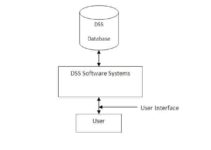Decision Support Systems (DSS)
A decision support system is an interactive computer-based system that serves the decision making needs of managers. It provides managers with information that enables them to make both semi-structured and unstructured decisions. A DSS employs various analytical models to perform a low-level analysis of data and produce information.
A manager can apply his knowledge to the system generated information and get a more clear view of the problem. The use of decision support systems usually increases the manager’s ability to make correct and balanced decisions.
A Decision support system possesses an interactive interface that makes it easier to use and provides real-time response to user queries. The use of various DSS tools helps in each stage of the decision making process that includes viewing a complex problem, designing the model to analyze the problem, developing alternatives to get a solution, and choosing a solution from the available alternatives. While the use of DSS often increases with the level of management, they are used at all levels and most often the users are also from the non-managerial staff.
Types of Decision Support Systems
The decision support systems can be broadly classified into two types, namely model-based DSS and data-based DSS.
1. Model-Based DSS
These systems are standalone systems and they are not connected with other major corporate information systems. The capability of analysis of these systems is supported by some strong theory (or model) along with a good user interface that makes them easy to use.
The use of various models in these systems helps them to perform what-if and other similar analyses. They are used for creating simulation models, performing production planning and scheduling, and creating statistical and financial reports.
2. Data-Based DSS
These systems can analyze huge amounts of data from different sources, such as organizational data, data from enterprise systems, and data from the web. The data collected from different sources is stored in data warehouses. A data warehouse is a database that can store present and past data extracted from various operational systems, and provide certain reporting and query tools.
Using these systems, managers are able to extract information from a large pool of data that otherwise would have remained hidden and unused. The extracted information helps managers in making better decisions. Note that the corporate information systems are a major class of systems that use data-based decision support systems. The main techniques that are mostly used in data-based DSS for analyzing the data are online analytical processing (OLAP) and data mining.
- Online Analytical Processing (OLAP): It is based on queries and can provide fast answers to complex business requests. It enables managers and analysts to interactively examine and manipulate the data available in the data warehouse from different viewpoints.
- Data Mining: It helps in extracting useful information by finding patterns or rules from existing data. This information is then used to predict future trends and behaviors.
Differences between Management information systems (MIS) and Decision support systems (DSS)
Management information systems (MIS) fulfill the information needs of an organization to a larger extent, but they are not sufficient for meeting all the needs of information and decision making. In some situations, where the nature of the decision is complex, the decision-makers would require additional information, analysis, an appropriate DSS model to support decision-making.
Some of the major differences between Management information systems (MIS) and Decision support systems (DSS) are as follows:
1. MIS deals with mostly structured problems, whereas DSS provides information that helps in analyzing and finding solutions to semi-structured and unstructured problems.
2. MIS provides information on business performance that helps managers to control and administer the day-to-day business activities. On the other hand, DSS provides information and various decision support techniques that help managers to analyze specific problems or opportunities.
3. MIS produces reports based on the routine flow of data; the format of these reports are predefined. In addition to regular reports, it may produce exception reports which help managers to analyze and control the cause and effect of the exception and take appropriate action.
On the other hand, the decision support system is interactive and provides quick responses to user queries. To obtain sales analysis reports, for example, containing figures related to the performance of sales based on the sales region, salesperson, etc., a sales manager needs MIS. However, to know the effect of changes in different factors like expenses on the promotion of a product, and compensation to the salesperson on the performance of sales, sales managers can interactively use decision support systems.
4. Management information system produces information by extracting and manipulating business data, whereas Decision support system produces information by performing analytical modeling of the business data.




